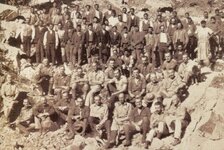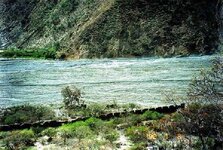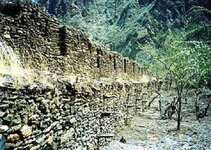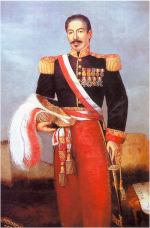Interested Party in UK
Hero Member
- Mar 2, 2013
- 729
- 1,825
- Primary Interest:
- All Treasure Hunting
Hi CI
Yes, thank you - that's the chap who allegedly found the tunnel during the last Sanders trip and returned to recover what was supposedly there. I have looked into that angle as well.
The more you delve into this one, the better it gets.
What intrigues me about this particular legend is the fact, that even though there has been treasure reputedly uncovered at Sacambaya/Plazuela on different occasions, there always seems to be a little bit more left...
An account from a 'Jesuit' source claimed that they retrieved the treasure sometime in the early 19th century or possibly the late 18th century. Colonel Fawcett, when he visited the site, claimed that a Bolivian had recovered the cache already some years prior to his visit. He did not detail a source. Then there is the story from a local man who found a golden bell weighing approximately 40lbs with his two sons during which one died through an accident. They bought land and cattle with the funds but did not search any more. Even during the 1960s search, they found small amounts of silver items simply lying around.
Even if we critically look at the question of whether this is all a hoax and simply a ruse used to fleece investors and the alleged documents were 20th century forgeries, it doesn't stand-up to scrutiny. Prodgers was very well versed in the machinations of treasure hunting in South America. He went to great expense to visit Sacambaya and it nearly cost him his life. If the San Roman document was a forgery, why did he manage to track down the 'caretaker' who was being paid by San Roman's family? That native chap was very real and knew the details well.
The Bolivian president during the 1870s also made a search but was looking in the wrong location. He received his information from another source so the story has been going on from well before the 20th century which would not fit in with the "hoax" theory. Jesuit records have been searched but do not detail a "monastery" at the location. I believe this is where careless use of words can easily distort a treasure story. There was most definitely mining going on; records indicate 13 different mines which then collected the collective wealth which was stored in a central location. The site itself had been used since Inca - perhaps even pre-Inca - times, so there was a base to speak of. Even in this day and age the place itself is remote and no large-scale expeditions have been made since Sanders (unless we accept that Nolte retrieved the gold in 1938 with the Americans).
I was going over old threads last night and the sharp wily old Birdy had posted some decent information and I believe had even looked into the Indies archives in Sevilla to track down information related to Bolivia and this site in particular...
There was also an American lady who ran a mining operation near Sacambaya who told of surreptitious searches going on as the groups would stopover at her site.
It would seem there is meat on this bone, and I am feeling peckish!
IPUK
Yes, thank you - that's the chap who allegedly found the tunnel during the last Sanders trip and returned to recover what was supposedly there. I have looked into that angle as well.
The more you delve into this one, the better it gets.
What intrigues me about this particular legend is the fact, that even though there has been treasure reputedly uncovered at Sacambaya/Plazuela on different occasions, there always seems to be a little bit more left...
An account from a 'Jesuit' source claimed that they retrieved the treasure sometime in the early 19th century or possibly the late 18th century. Colonel Fawcett, when he visited the site, claimed that a Bolivian had recovered the cache already some years prior to his visit. He did not detail a source. Then there is the story from a local man who found a golden bell weighing approximately 40lbs with his two sons during which one died through an accident. They bought land and cattle with the funds but did not search any more. Even during the 1960s search, they found small amounts of silver items simply lying around.
Even if we critically look at the question of whether this is all a hoax and simply a ruse used to fleece investors and the alleged documents were 20th century forgeries, it doesn't stand-up to scrutiny. Prodgers was very well versed in the machinations of treasure hunting in South America. He went to great expense to visit Sacambaya and it nearly cost him his life. If the San Roman document was a forgery, why did he manage to track down the 'caretaker' who was being paid by San Roman's family? That native chap was very real and knew the details well.
The Bolivian president during the 1870s also made a search but was looking in the wrong location. He received his information from another source so the story has been going on from well before the 20th century which would not fit in with the "hoax" theory. Jesuit records have been searched but do not detail a "monastery" at the location. I believe this is where careless use of words can easily distort a treasure story. There was most definitely mining going on; records indicate 13 different mines which then collected the collective wealth which was stored in a central location. The site itself had been used since Inca - perhaps even pre-Inca - times, so there was a base to speak of. Even in this day and age the place itself is remote and no large-scale expeditions have been made since Sanders (unless we accept that Nolte retrieved the gold in 1938 with the Americans).
I was going over old threads last night and the sharp wily old Birdy had posted some decent information and I believe had even looked into the Indies archives in Sevilla to track down information related to Bolivia and this site in particular...
There was also an American lady who ran a mining operation near Sacambaya who told of surreptitious searches going on as the groups would stopover at her site.
It would seem there is meat on this bone, and I am feeling peckish!
IPUK









 Or a Masochist.
Or a Masochist.





